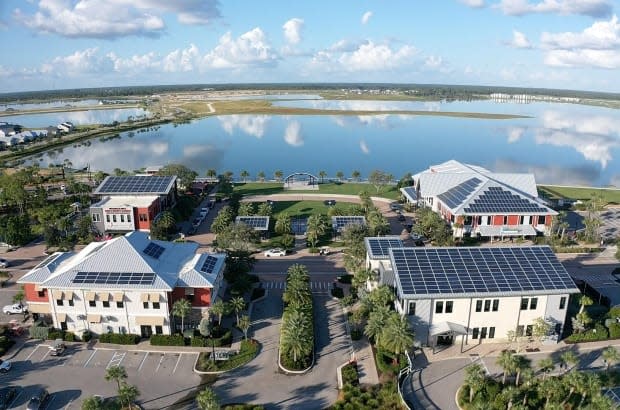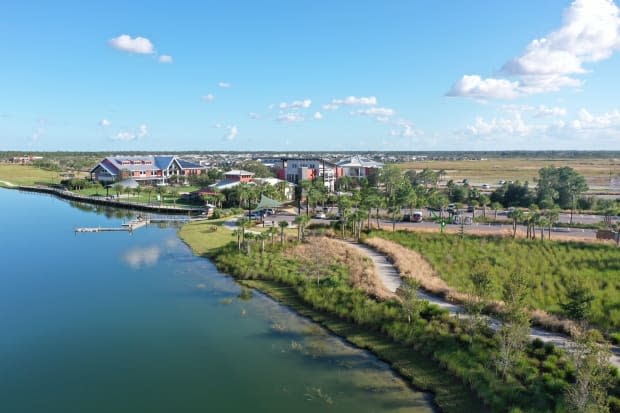What N.S. can learn from solar-powered Florida town built to withstand intense storms

As Hurricane Ian bore down on Florida earlier this month, thousands of residents of a unique solar community never lost power, cell coverage or internet.
Babcock Ranch — billed as the first entirely solar-powered city in America — was built for this.
The community, located a few kilometres northeast of Fort Myers, has a mix of rental and real estate properties that vary in price from $200,000 US to more than a million.
What these properties share in common is resiliency in the face of climate change.
"We had people here experiencing Category 4, almost Category 5, conditions, and were able to sit there and watch it on TV," Syd Kitson told CBC Radio's Information Morning on Friday.
Kitson is the CEO of Kitson and Partners, the company that built Babcock Ranch. He spoke with host Portia Clark about how the community was built and what other cities along the Atlantic Coast can learn.
Their interview has been condensed and edited for clarity.
You can listen to the full interview here:
What were the things that were built into Babcock Ranch to make it resilient to hurricanes and other natural disasters?
First of all, the community itself is [nine metres] above sea level. Here in Florida, [nine metres] above sea level is a virtual mountain and so that was important to us because we wanted to be above the storm surge. But we also then took a look at the water management system, and one of the things that we learned very quickly is that what you need to think about is following the natural flow ways that are on the property. We went back and looked at maps from, you know, 100 years ago and said where does that water go just naturally? And right in the middle of the hurricane when it was raining, you could really see how that water flowed very, very well throughout our community.

We also planted native plant materials throughout the community … and during Ian we had 150 mph winds here. What we found was all of the native plant materials were still standing.... We own our own water and wastewater utility plant so when we built it we made certain it was elevated high enough so it could never be impacted by water or the floods. It was able to handle wind loads so the people who lived here had clean running water throughout this event ... I would say the thing that was most comforting for [residents of Babcock Ranch] was the electricity never went out.
How? That seems like a miracle so do you have buried lines there?
Yes. We went and talked to Florida Power and Light early on. We're the first solar power town in America. We have 150 megawatts, that's 700,000 panels on about 340 hectares. Now that's all fine and good, but when a storm comes in like Ian did and there's cloud coverage for a long period of time, you can no longer depend on that solar energy. So we then had to draw from the main utility. But Florida Power and Light became our partners in trying to figure out how … we harden our infrastructure so that we won't lose electricity.
So the poles that were built are concrete poles coming to Babcock Ranch. Then as soon as it got to our substation that's on our property, everything goes underground so if you come to Babcock Ranch, there's not a single telephone pole or power pole or anything here — 100 per cent of our utilities are underground. The only way that we would have lost electricity is if one of these concrete poles that can handle Category 5 hurricanes somehow failed and of course that didn't occur.

Was there any damage, even to the solar panels, for example? We saw that here in Nova Scotia that some of the solar panels took a hit during the post-tropical storm.
We went out and did a survey and so did Florida Power and Light and not one of the solar panels out of 700,000 was dislodged. It was pretty remarkable to see that. We did have minor damage and we learned stuff, too. I mean we learned things that [it will take] to be prepared next time. I mean some of our signs went down and there were signs that were essentially temporary signs anyway. But [there was no damage] that was structural, nothing that impeded the life of any of the people that live here.
When you say hardening the infrastructure, for example, around the solar installations, does that mean regulations to withstand a certain speed of wind?
Exactly.… I think it started probably back in 1992 when Andrew came through as a Category 5 hurricane and really just wiped out an entire community. The building codes changed and they changed for the better. It was a little bit more expensive, but long term we have found it to be tremendous savings. When you think about the homes here at Babcock as an example, the most damage we had here were maybe some roof shingles or just minor things, nothing of any consequence. That's because of the great building codes that we have here in the state of Florida.

So any advice for us, Syd, about shoring up our infrastructure for the next big storm given we cannot build most of our communities from scratch.
Start with those utilities and take a look at how [they performed]. Were you able to deliver water? Were you able to deliver electricity? How did all those things perform when Fiona came through? And then start to think about how you can start to improve on those things. You can't do it all at once. It's probably not feasible, but that's OK because if you just take it kind of one step at a time and improve it and then develop building codes that make more sense for the new world that we live in today.
MORE TOP STORIES

